[Previous entry: "Monday Night - October 20, 2003"] [Main Index] [Next entry: "Lisa's Pumpkin Carving Party - October 26, 2003"]
10/31/2003 Archived Entry: "Canadian Défi - October 18, 2003"
Our Participation in the Canadian Défi de L'Île de Montréal
On October 18, 2003
By Lisa B
POURQUOI CANADA ?
Is The Défi An Inline Skating Race?
The Défi de L'Île de Montréal (The Challenge of the Island of Montreal) is a 128K/80-mile inline skating event that tours clockwise around the perimeter of the Island of Montreal. This was its eighth successful year, and had the highest number ever to register (202), and the most to ever to finish (163). It is held every year on the third Saturday in October, and this year was the second year in a row that I have completed the Challenge.
The organizer, Robert Fortier, had inline skated all the way across the United States in 1994. After enjoying the long distance skating, the following year, he organized the Défi, which has been family operated and financed ever since. The event does not try to compete with bigger budget races. It is all done on a shoestring with a low entry fee (only $25) and no solicitation of sponsorships. There are extra nice family touches too, like a special greeting at the finish area by Robert’s wife, Diane Fortier. She graciously waits well into the dark for the last skater to come back home.
For many local Canadian skaters, the Défi gives purpose to yearly training, much like A2A does for a lot of us. Those finishing in under 8 hours are awarded the Gold Medal; under 10 hours, the Silver; and under 12 hours, the Bronze. These are not cheesy medals either but rather unbelievably big, beautiful, and heavily weighted ones (in fact, the medals are almost identical to the one which I won in the 1994 Winter Olympics, in Lillehammer). Finishers also receive a laminated certificate with their name and finishing time.
The Défi is not considered by the organizer to be a race, but rather an “event.” However, as much as Monsieur Fortier insisted it is not a race, I notice that when times are recorded and medals given out, any event can turn into a race! Some (mostly Canadian) top speed skaters, who show up, go all out. Other skaters are purely recreational, and take their time while enjoying the beautiful course.

(Photo by Eva M.) The winner, Medhi Cherif (2nd from
the Right) set a new course record of 5:06. This is the
Lead Pack, which came in three minutes later at 5:09.
They all would have broken 5 hours for the first time
ever on this course, but the police detained them in one
of the villages at 6:30 AM for 15 minutes. The winning
woman, Cathrine Grage (left), came all the way from
Copenhagen, Denmark.
The Défi’s Great Website
The event’s website is extremely informative and well maintained by Rod W., an inliner from Sherbrooke, Quebec. Everything you need to know about the race during race day is well detailed. On the website and in other printed literature, the skaters are warned to be careful when in traffic, and to make themselves visible. Similar to A2A, the roads are not closed, but unlike most of A2A, there are no policemen helping the skaters through the intersections. Therefore, the skaters are instructed to stay on the route’s bike path, when possible.
The race kit contained two big reflective numbers, reflective tape, and reflective ribbons to wear. Some checkpoint stops consisted only of a helpful man, standing on a corner with plastic water jugs. The skaters carry their own food the whole way, or else stop at stores along the route. The lack of a huge amount of support is clearly explained on the Défi website. Click here to enter the Défi website
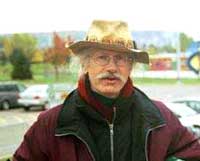
Défi Webmaster and Roller Montreal Guru - Rod W. Rod is
a very warm and hospitable person. He is also a published
poet, multi-lingual, and a great speed skater.
Manhole Covers and other Wacky Hazards
The Défi starts in the dark at 6AM. It starts on a smooth bike path which has flares lit to show the way, along with volunteers pointing out the turns. Skating in the dark, in a long pace line at 6AM, was really exciting for me (others found it scary). After the path, we reached a quaint village called St. Anne De Bellevue. Here the pavement varies, with some of it great and some parts horrible. I was skating with an old A2A friend, Ed L. from New York, during that stretch. There are manhole covers every 10 feet, and since a few of newbies in the paceline were not calling out the hazards, we both unsteadily rolled right over them. To quote Ken C., who was there from California:
“There were surprises like sand, dirt, ripped out sections, lots of manholes covers. I don’t know if it is a local custom or what, but when an obstacle like a manhole cover came upon our pace line, instead of dropping your arm pointing out the danger, they would attack it, jumping to the side at the last moment. So I ended up going through lots of crap.”
Although the Roller Montreal Club has organized a weekly group that trains skaters, many Défi skaters train solo.
The path is beautiful and follows the St. Lawrence River for many miles. Around 7:30 the sun rises over the water, which is simply a sublime sight. Skating past this stunning scenery is a unique way to see Montreal. This exquisite view, the big flock of skaters, and the background noise of bilingual chatting put me on a long-lasting, total high. I have rarely been filled with such moments of happiness. I wish I could travel to all the out-of-town skate races- but like a lot of us- I can only pick one or two per year to attend. It was during this surreal early morning segment that I knew I had made the correct choice, when choosing to return to Montreal.
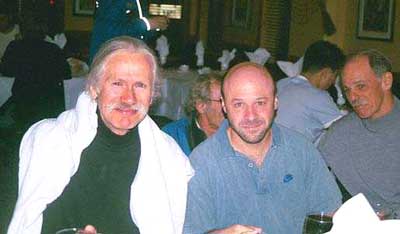
Rod W, Ed L. (Empire Speed) and Frank C, also from
New York City, at the post race celebration.
Isn’t it Cold in Montreal?
A week before leaving home, I received my Défi T-shirt in the mail. Included was a letter from Robert Fortier that said, “Last year the T-shirts were sky blue and the sky was gray…this year the T-shirts are gray!” Of course, everyone hopes for beautiful “Indian Summer” weather. It was cold on race day but I felt just fine. On Friday night, there was a dinner held by the Roller Montreal Club for out-of-towners. The subject was the weather and how to dress for the big day. My main concern was overdressing and getting too hot, and then having to carry my discarded jacket. Rod, Ed, and Frank warned me to rethink that concern - because it was going to be very cold. I wore 3 layers on top (2 light and one medium), one pair of tights and a pair of gloves, and I never got too cold or too hot. The day’s temperature was 42-48F. When skating on a cold day, the danger is in stopping too long in one spot, because then you could become very cold from the sweat on your body.
Navigational Strategies: Forget the Turn Sheet
It is better to hook up with a local skater (if possible), because the map and directions given out are in French and not easy to understand. There is an English version on the website, but this must be printed out before you leave. Ken C. had some trouble figuring it all out and I can certainly understand why! Think of trying to skate A2A by relying solely on the turn sheet, and pretend you cannot read English. There are yellow arrows and “DÉFI” painted in the streets; but at A2A, the yellow “S”s are much easier to see. At the Défi, since the yellow markings are not nearly as big, the route can get confusing. To be fair, it is hard to compare anything to the Athens-to-Atlanta route markings, because those are the World’s Largest Painted Race Directions. (I still don’t know y’all get away with painting such big S’s in the street. Oh that’s right… Mark Day, Henry and others get out there at 4AM and bust their butts!)
I was with my friend Lisa P from New York, who was riding her bike and helping me, by carrying some of my food. The cyclists are welcome to come along, but are asked to start after all the skaters have left the start area. So she was behind me. She caught up to me at the 25-mile mark, where we stopped for a “Pipi-Stop” (Bathroom break as they say in French) at the “Couche-Tard”, a Canadian QT. As I was finishing up my pitstop in the gas station, I saw a pack of 12 skaters passing by and decided to catch up to them. I told Lisa I was taking off and left her in the store.
I skated as fast as I could, dodging cars and jumping curves. This part is called Château Pierrefonds Ave., and is in Section 2, which is a horrendously busy street. Worse, the bike path crosses an intersection every 1/10th of a mile. There are ridges purposely placed into the concrete of the bike path as it arrives at a street crossing (to aid the blind). Also on the ground were holes, gravel, cracks, sticks and sand. I finally caught them but was now out of breath. Here I met up with French Canadian skater, Simon D, of Montreal. He is a 5-time Défi veteran, and we stayed together until the end. I was lucky to find a local who knew the route: I could then ignore the arrows, turn sheet, and French map.
The X-Games
The worst part of the event is its Section 5, or the last 18 miles. It is a treacherous part the route, and since it is the final part of the course, it sticks in everyone’s head as an enduring memory of torture. Usually, there is an exceptionally strong headwind on this street too, but this year we were extremely lucky because it was not as strong. Due to the harsh winters, the skating surfaces you will find on rue Notre-Dame can be simply miserable. The bike paths here are buckled in places, where suddenly there is a series of tiny little rolling ups and downs, like being on a mini roller coaster ride. The path is full of bricks, cracks, gravel, leaves, bumps, holes, sand, and rocks. Did I mention bricks?
At the end of each part of the path where it intersects with a street, the path is paved with 10 feet of bricks before each intersection. Not only is necessary to make it over the bricks, but we had to watch for cars, potholes, and sand while crossing each street. Just as I hit each street- often just barely avoiding a car- it was time for another 10 feet of bricks! If you are lucky, as I often was, you get all those obstacles at once, along with the buckling fun! I did this for about 10 miles or so, dreaming of the smooth Gatorback in Georgia.
When your feet are in a lot of pain, and you’re already exhausted from having skated more than 65 miles, it becomes very difficult to concentrate on your X-Games, freestyle-aggressive, obstacle-avoiding skating moves - especially in speed boots! Hey Paul K, if you want a real “Tech Skate” come on up and try this!!!
I followed Simon. We were working well together, each taking pulls, and he knew the way. He usually told me what was coming next. This reminded me of all the years at Athens-to-Atlanta when I played host, by describing to the visiting skaters what is coming up. Where the bike path crossed the street, there was speeding traffic, and trucks coming headlong toward us at 70 mph. We crossed the streets swiftly, hopped the curbs and onto the sidewalks (at the last possible second before getting run over), and into holes, gravel, rocks and cracks. Ouch!
What Level Skater Can Complete The Challenge?
Although the course is completely flat, the Défi is very tough due to these rough surfaces. Having no hills made it easy on my heart rate, since I never exactly “bonked.” Some argue that having no down hills to “rest” on makes you more exhausted. For these reasons, even though the Défi is seven miles shorter than A2A, the overall finish times are generally slower. Then again, each year, speed records are being broken on the course, and will continue to be broken well into the future. The Défi is not for the beginner skater or for those who are uninitiated to street skating. The Pro Elite skaters may not feel an incentive to participate, because it is not officially a race and it is a tad hard on the body. A few pro-level skaters do show up each year too. If you are a more advanced recreational skater, a middle of the road distance junkie, or an advanced or fitness category skater, then you may find this a perfect test of endurance and skill.
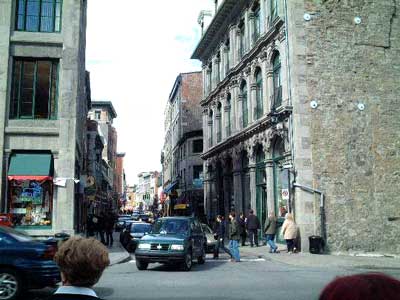
Typical Street in Old Montreal.
When the Jacques Cartier Bridge comes into view, you are almost finished! This is when you can smile!
The last part is skating through the touristy Old Montreal area, where many of the buildings are just as they were in the 17th and 18th centuries. As we were passing through that area with just 3 kilometers to go, Simon caused quite a scene. As we were skating down a hill, he grabbed my hand to hold it over our heads together in triumph and starts screaming to everyone in French: “125 Kilometers! We did it! 125 Kilometers!! We did it!!” We got some stares along with a big ovation from the crowds on the streets, something I will never forget.
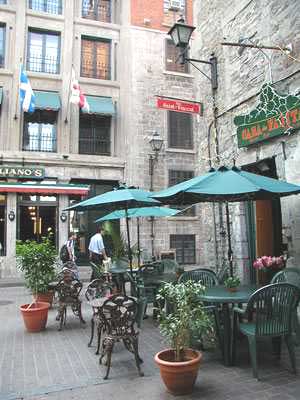
Typical Café in Old Montreal
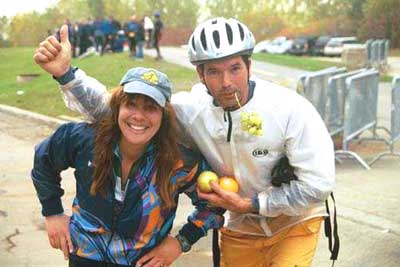
Simon D. and I were really happy after finishing together
in 7:23. I was just happy to be alive after the daredevil
freestyle stunts we pulled in Section 5. Simon certainly is
a man of many talents: Not only can he keep his balance
on rue Notre- Dame but he can also balance grapes in his
teeth!
Lame Excuses
I finished in 7 hours 23 minutes. Not too great of a time, but good enough for the Gold Medal. I was 74th out of 163 finishers. I know I can do it faster, but this year (as always), I have my lame excuses. I can wrap up my whining in one sentence: I have some severe ongoing injuries, no comfortable skates, and an increase in personal responsibilities, leaving me little time for training.
My right foot was in pure agony the entire 7 hours. My right foot felt like the bone was broken on the bottom. This was a classic Catch-22: If I tightened the laces, the bone felt much better, but tightening the boots aggravated my ankle, where I have a severe case of lace bite. Tightening the laces caused excruciating pain - a piercing stab into the front of my ankle. I had to choose the less painful of the two painful pains. I finally chose the bottom of the foot anguish because I could no longer even skate 3 steps with the ankle torture. Strangely, my left foot felt perfectly fine.
I actually wore my old Harper speed skates during the event. The “Lesser of the 3 Evils” I was calling these boots, because all 3 pairs of skates I own cause me problems. Having no other choice, I decided to wear the Harpers only a few days before I left. I did not have time beforehand to test them out. To help with the rough pavement, I would recommend soft wheels for this route: a 78 durometer would be perfect. I plan to use these wheels the next time I skate in the Défi. If you have comfortable rec skates that you just love, wear those. But keep in mind the pain of the feet, or to use an expression coined by Ken C, “The pain of ‘De-Feet of the Island of Montreal’.”
Oh Canada?
Why do I do it if it is so hard? Why do I go all the way to “cold freakin Canada” for this non-race, instead of attending a major race here in the States?
I like the non-commercial simplicity of the event. It is an enormous physical challenge, requiring a lot of courage. But mostly, it is because Montreal feels like Europe. I love the international, cosmopolitan atmosphere there. The steaming hot café au lait was delicious and authentic: it was served in a great big ceramic bowl, just like in France. All my life, I have schemed for ways to get over to Italy and Europe, because suburban Georgia bores me to tears. Montreal is sort of an easy way to pretend you are in an exotic city much different from your own, but that is because - it is. Pretending to be an international bon vivant has always been a hobby of mine.
I acted out two of my ultimate fantasies at the same time by imagining all weekend that I was an international jet setter and a world-class speedskater. I’ve made a lot of great friends up there. I am learning French, I mean really learning it! By Sunday I was thinking and speaking in French. I love the Canadian people because they offer a different point of view and a different way of life, which always leads me to re-examine my own culture. Vive la différence! I love the whole bilingual French-English thing. The language barrier excites me. I love having to be forced to reach deep into my brain to remember a verb that I studied, to make myself understood. I love when I can get my point across even with my poor accent and bad grammar. The bilingualism used by so many Canadians impresses me and makes me jealous.
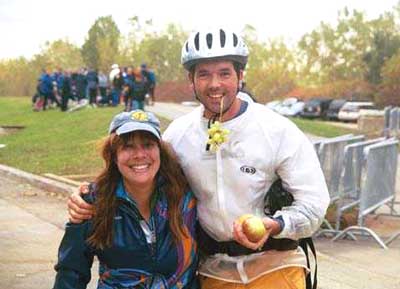
Notice the joy on my face as I realize my life long dream:
combining my phony international jet- setting aura with
my fake speed skater persona.
Melanie Watson (RoadSkater.net), of Raleigh North Carolina, came to the Défi for her first time (She speaks such beautiful, fluent French that I immediately wanted to strangle her). Melanie has only recently started skating, and skated the Défi in her new Bont speed boots. Although she was still suffering from an A2A injury, through her sheer determination and stubborn willpower, she finished in time for the bronze!
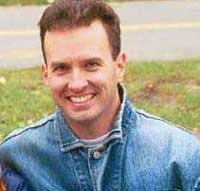
Mark Sibert, who just took over 2 hours off his
personal best at A2A 2003, flew to Montreal to
find out if his newfound speediness was some
kind of fluke. But no, this guy really is fast: he
broke 6 hours and came in 11th!
The Canadian Welcoming Committee
On Saturday night, after the post-race dinner, we went to a Discothèque called Thursday’s. I cannot believe I danced for hours after skating 80 miles. I am sure that the Canadians put something in the wine. I am not really a Disco Chic but that place was hopping. There were many Toronto Maple Leafs fans celebrating their victory over the Montreal Canadiens, which took place at the Centre Bell Arena earlier right down the street. It had a general "meat market" atmosphere which I found most appealing.
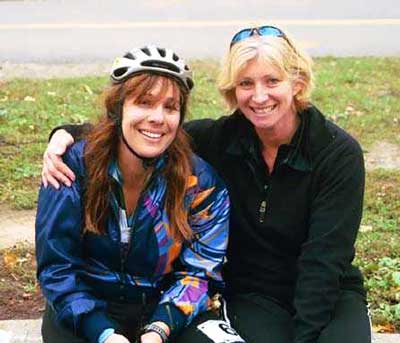
Here I am with my best friend from New York, also
named Lisa. She biked the 80 miles. Les Deux Lisas
had a fabulous time at the disco. She came up with
a very effective pick-up line for use during our trip:
“Hi! You must be The Canadian Welcoming Committee!”
My Grandfather was Insane
The weekend was too short. I was just getting all Frenched-out when it was time to leave. I had to stop being a Cosmopolitan Globe-Trotting Skater and go back to being an American Suburban Soccer Mom. I experienced my usual reverse counter culture shock upon arriving back home. I was depressed on the plane because I had to go back to speaking English: “A Diet Coke Please, Thank You”.
At Montreal’s Dorval Airport it is necessary to go through U.S customs before leaving there rather than when arriving in the States. There is a painted line on the floor behind the ticket counter. As you cross the line, a sign says, “Welcome to the United States of America.” And then you are in the Good Old U.S.A. But technically, well geographically you are still in Canada, but politically, you are not; because our country actually owns this section of the airport, so it is U.S. territory. Even though I was still over the Canadian border, I was in United States!
I was still drunk from the disco, so contemplating all this gave me a mild headache. It also reminded me of the time my grandfather was beside himself with happiness when he went to Niagara Falls. He had one foot in Canada and one foot in the U.S.A, and always told the story about how he was flabbergasted to be in 2 countries at once. I believe I inherited my madness from him. After crossing the “border” in the airport, I was interrogated by US Customs Officials who ask idiotic questions such as, "What was the purpose of your visit?" … If they only knew …









